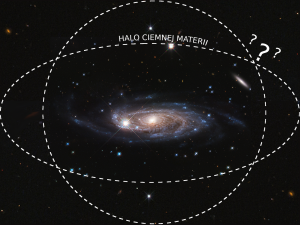What is the shape of the dark matter halo?
26-02-2021
Ph. D. Anna Durkalec from the NCBJ Astrophysics Division belongs to the group of 12 associate professors awarded in the Institute in 2020. Dr. Durkalec begins the description of her research by asking a few questions:
What is the shape of the dark matter halo?
At the moment we are not sure…but of course, we would like to know.
But let’s start from the beginning and ask more general questions.
What is the dark matter halo? and more importantly – what is dark matter?
The answer to this last question is not easy. We simply don’t know the nature of dark matter. What we do know is that there is a lot of it in the Universe and it dominates over the visible matter, i. e. the one from which the galaxies, stars, planets, and humans are made (there is 5–6 times more dark matter than visible matter!). Another problem is that we are not able to directly observe dark matter because it doesn’t emit or reflect any kind of electromagnetic radiation (light). We can only observe the effects of its interaction with visible matter because these two components of the universe are linked by gravity. For example, dark matter affects the rotational velocity of dust and stars in galaxies and the velocity of galaxies in clusters. Sometimes dark matter acts like a giant lens – its enormous mass causes the light of galaxies to bend (phenomena known as gravitational lensing). Moreover, without dark matter, it would be extremely difficult to explain the changes that have occurred in the large–scale structure of the universe from its inception to the present.
We know that dark matter plays a huge role in the universe. Without it, there would be no galaxies, as they form and evolve in the local overdensities of dark matter. This means that every galaxy and every cluster of galaxies is embedded in a surrounding „halo” of dark matter. In theory, galaxies can therefore be used to describe the distribution of dark matter in the universe. To do that, one must create a physical model, that combines the mass, shape, and density distribution of dark matter with the distribution of galaxies of different mass, brightness, color, or shape. Such models are called HOD – Halo Occupation Distribution models.
In my work, I focused on the study of the relationship between dark matter and galaxies as seen in the universe 10 billion years ago. Using the data from VIMOS Ultra Deep Survey (VUDS) I found that shortly after the formation of galaxies, there Was a clear relationship between the mass and the brightness of galaxies and the mass of dark matter halo in which they were located – the more massive and brighter galaxy, the more massive the halo occupied by it.
However, to correctly estimate the mass of the halo, it is necessary to determine its shape. For many years it was assumed, that the dark matter halos were spherically symmetrical. This assumption is, of course, a simplification – sufficient or even necessary for studies conducted based on observations of a relatively small number of galaxies.
However, in the era of currently planned huge galaxy surveys, covering several or even tens of millions of galaxies, this assumption may prove to be inadequate.
In our latest work, we propose a solution to this problem. It turns out, that most dark matter halos, especially the most massive ones, have an elongated shape (similar to an egg). This is mainly due to the pressure of dark matter mass and/or gas flowing into the halo from a certain direction. The assumption of a spherical – symmetrical halo shape is therefore not only an oversimplification but also influences the measurements of dark matter mass in the halo significantly overestimating them. So we proposed a new model that takes into account possible halo asymmetries. This model can be successfully applied in new works based on planned large sky surveys.
These fundamental discoveries bring us closer to solving key problems: firstly, they allow us to more closely examine the changes that the universe has undergone from its inception to the present, and secondly, they bring us closer to answering questions about the nature of dark matter.
[1] https://www.aanda.org/articles/aa/pdf/2018/04/aa30734-17.pdf





